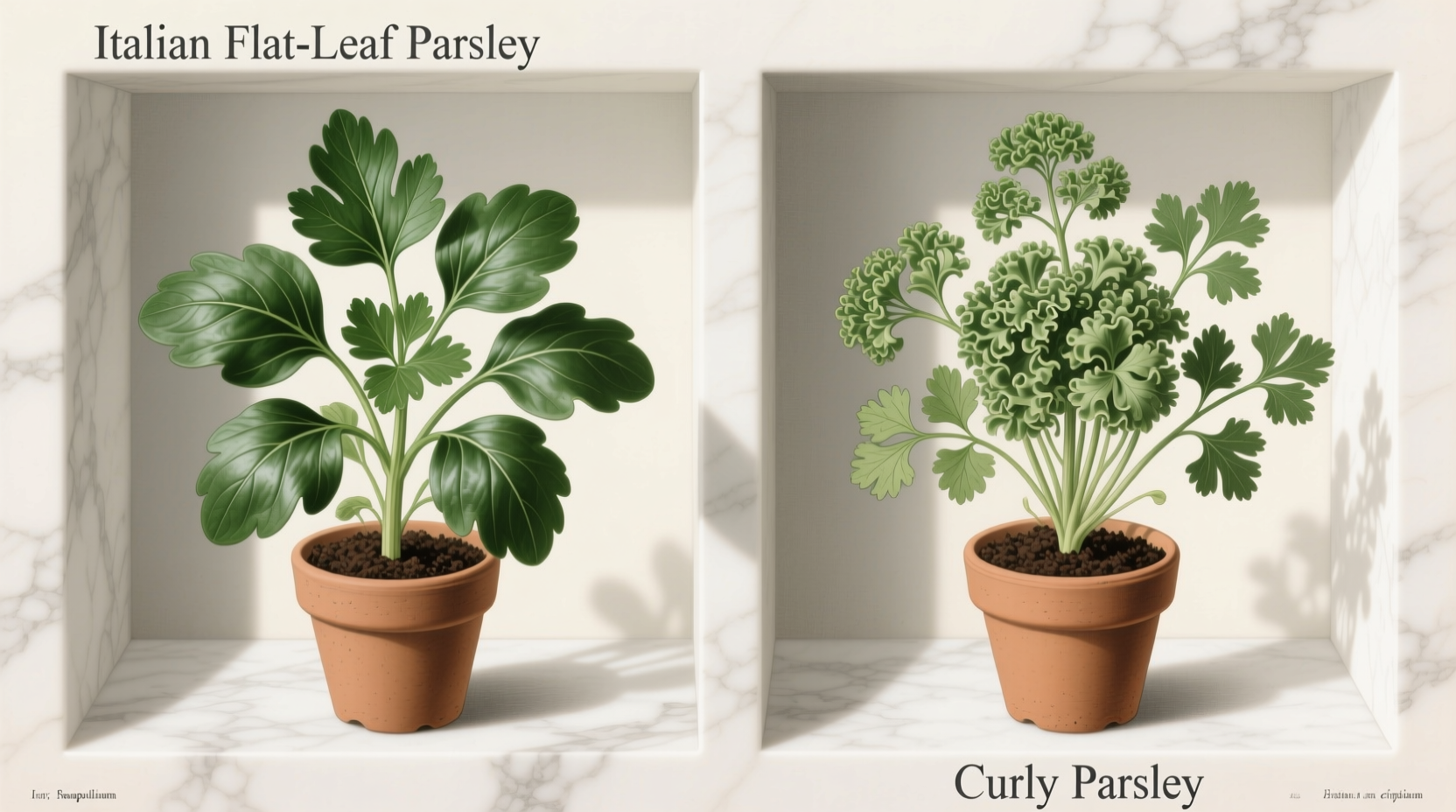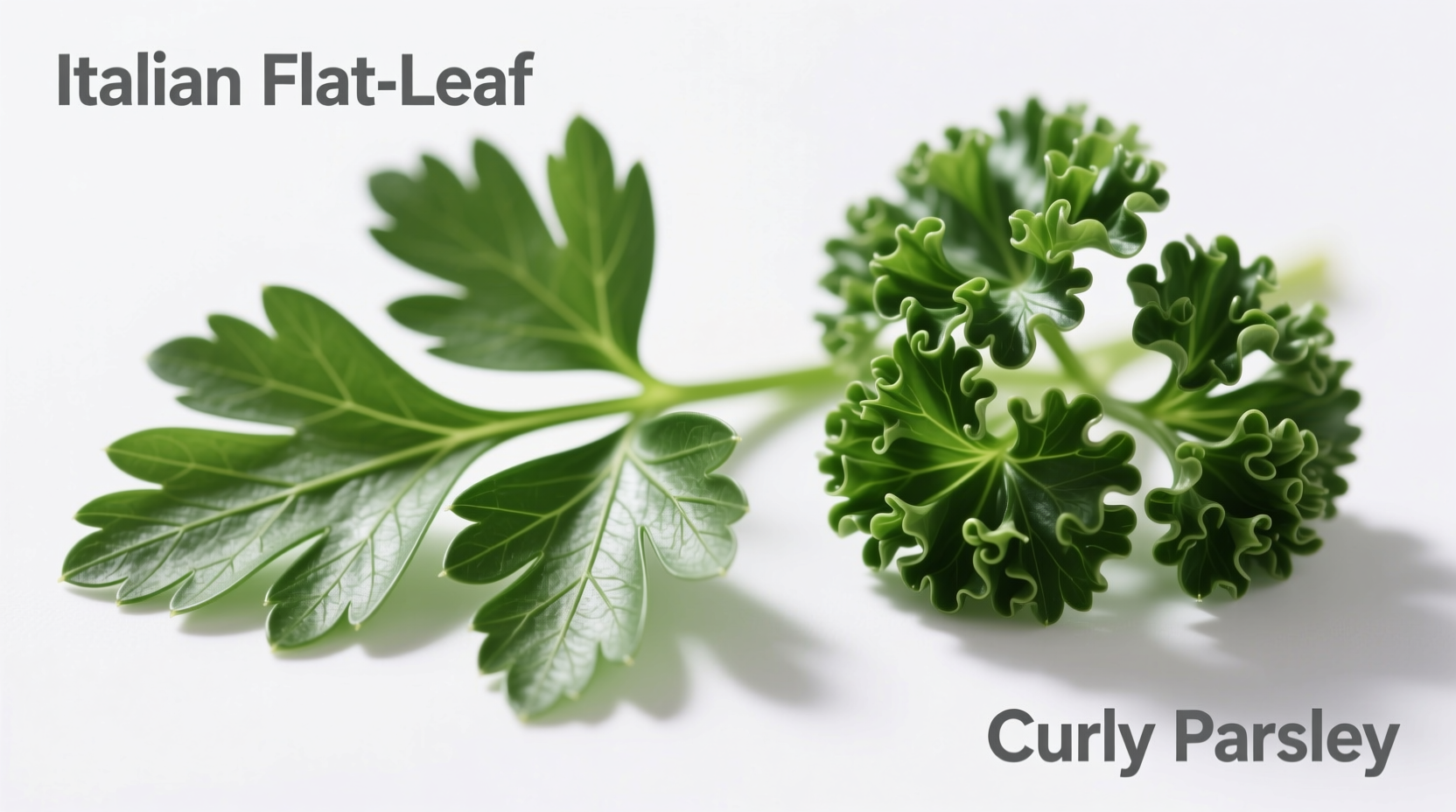Italian (flat-leaf) parsley offers a stronger, more robust flavor ideal for cooking, while curly parsley provides a milder taste and attractive visual presentation better suited for garnishes. Choose Italian parsley for sauces, stews, and dishes where herb flavor matters; select curly parsley for finishing touches and decorative elements.
When standing in the grocery store staring at two nearly identical parsley options, you've probably wondered: what's the real difference between Italian and curly parsley? As a chef who's worked with both varieties across dozens of European kitchens, I can tell you they're not interchangeable substitutes. Understanding these differences transforms how you approach recipes and elevates your cooking from ordinary to exceptional.
Quick Reference: Italian vs Curly Parsley at a Glance
| Characteristic | Italian (Flat-Leaf) Parsley | Curly Parsley |
|---|---|---|
| Botanical Name | Petroselinum crispum var. neapolitanum | Petroselinum crispum |
| Flavor Profile | Bolder, earthier, more pronounced herbal notes | Milder, slightly grassier, less intense |
| Texture | Softer leaves, easier to chop finely | Firmer, more resilient leaves |
| Culinary Best Uses | Cooking applications where flavor matters (sauces, stews, pesto) | Garnishes, salads, visual presentation |
| Storage Life | 5-7 days refrigerated | 7-10 days refrigerated |
Flavor & Aroma: The Critical Distinction
Italian parsley contains higher concentrations of apiol and myristicin—volatile compounds responsible for its distinctive flavor profile. According to USDA nutritional analyses, Italian parsley delivers approximately 20% more essential oils than its curly counterpart, creating that pronounced herbal character chefs prize in cooked dishes. When you crush a leaf between your fingers, Italian parsley releases a more intense, almost peppery aroma that holds up during cooking.
Curly parsley's tightly curled structure traps fewer aromatic compounds, resulting in a milder flavor that disappears quickly when heated. This isn't a flaw—it's a feature. The subtle taste makes curly parsley perfect for raw applications where you want herb presence without overwhelming other ingredients.

When to Choose Italian Parsley
Professional kitchens overwhelmingly prefer Italian parsley for cooking applications where herb flavor matters. Its softer leaves integrate seamlessly into dishes without distracting texture. Consider Italian parsley your go-to for:
- Sauces and braises—the flavor penetrates liquids effectively
- Pesto and herb oils—creates more vibrant, complex infusions
- Stuffings and meat mixtures—distributes evenly without tough bits
- Middle Eastern and Mediterranean dishes—authentic to regional recipes
When making tabbouleh, for example, substituting curly parsley creates a noticeably different texture and milder flavor profile that traditionalists would consider inauthentic. The Middle East Institute's culinary documentation confirms Italian parsley's essential role in authentic Levantine cuisine.
When Curly Parsley Shines
Don't dismiss curly parsley as merely decorative. Its unique properties make it indispensable in specific applications:
- Garnishing hot dishes—holds shape better than Italian when placed on steaming plates
- Raw applications—adds visual interest to salads without dominating flavor
- Longer storage needs—the tightly curled structure retains moisture better
- Delicate dishes—won't overpower subtle flavors like fish or egg preparations
Food science research from the University of California's Agriculture and Natural Resources department shows that curly parsley's complex leaf structure creates air pockets that help maintain crispness longer than flat-leaf varieties. This structural advantage explains why professional platers often choose curly for garnishes that must remain presentable for extended service periods.
Nutritional Comparison: Surprising Similarities
Despite their flavor differences, both varieties offer nearly identical nutritional profiles. According to USDA FoodData Central, a quarter cup of either parsley type provides:
- Approximately 1 calorie
- Over 100% of your daily vitamin K requirement
- Nearly 15% of daily vitamin C needs
- Significant amounts of folate and iron
The minor differences in nutrient concentration aren't significant enough to influence culinary decisions. Choose based on flavor and texture needs rather than nutritional concerns.
Substitution Guidance: When Swaps Work (and When They Don't)
While substitutions are possible in a pinch, understanding the limitations prevents culinary disappointment:
- Italian for curly: Works well in raw applications but creates a stronger flavor profile
- Curly for Italian: Acceptable in garnishes but fails in cooked dishes requiring pronounced herb flavor
- Never substitute in traditional recipes like Lebanese tabbouleh or Italian gremolata where the specific parsley variety is integral to authenticity
When substituting, adjust quantities: use 25% more curly parsley to approximate Italian's flavor intensity, or reduce Italian parsley by 20% when replacing curly in raw applications.
Selection and Storage Secrets
Professional chefs evaluate parsley using these criteria:
- Color: Vibrant green without yellowing or browning
- Texture: Crisp, not limp or slimy
- Stem condition: Firm, not woody or dried out
For maximum freshness:
- Treat parsley like cut flowers—trim stems and store in water
- Cover loosely with plastic bag in refrigerator
- Change water every two days to prevent bacterial growth
- Never wash until ready to use (moisture accelerates spoilage)
Common Mistakes to Avoid
Even experienced home cooks make these parsley errors:
- Using dried parsley as substitute: Dried versions lose 70% of volatile flavor compounds—fresh is essential
- Adding Italian parsley too late: Its flavor needs 5-7 minutes cooking time to properly integrate
- Over-chopping curly parsley: Creates bitter compounds from damaged cell walls
- Storing near ethylene-producing fruits: Apples and bananas accelerate parsley deterioration
Remember that parsley stems contain concentrated flavor—finely chop the lower third of stems for cooking applications while reserving leafy tops for garnishes.
Putting Knowledge Into Practice
Next time you're preparing a dish, consider these real-world applications:
- For a classic chimichurri: Use 75% Italian parsley with 25% curly for balanced flavor and texture
- When garnishing consommé: Curly parsley maintains integrity in hot broth better than Italian
- For herb butter: Italian parsley creates more flavorful compound butter that stands up to cooking
- In tabbouleh: Authentic preparation requires Italian parsley for proper texture and flavor balance
Understanding the difference between Italian and curly parsley varieties transforms how you approach recipes. Rather than viewing them as interchangeable, recognize each as a specialized tool in your culinary arsenal. The right choice elevates your dishes from good to exceptional while honoring the traditions behind each preparation.











 浙公网安备
33010002000092号
浙公网安备
33010002000092号 浙B2-20120091-4
浙B2-20120091-4